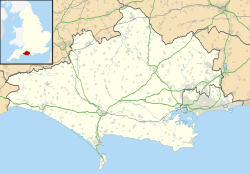Duropolis facts for kids
| Location | Winterborne Kingston |
|---|---|
| Coordinates | 50°47′N 2°13′W / 50.78°N 2.21°W |
| Type | Settlement |
| History | |
| Periods | Iron Age |
| Associated with | Durotriges |
Duropolis is an amazing ancient site in Dorset, England. Archaeologists believe it was the very first planned town in Britain! It's an Iron Age settlement, meaning it was built a long, long time ago, around 100 BCE. That makes it even older than some Roman towns in Britain, like Silchester.
Contents
What is Duropolis?
Archaeologists named this site Duropolis after the Durotriges, an Iron Age tribe who lived in this area. This settlement might have been built after people left a nearby hillfort called Maiden Castle. This happened around the 1st century BCE.
How Was Duropolis Found?
Students from Bournemouth University first found Duropolis in July 2015. They were part of a project called the Durotriges Big Dig. They uncovered the remains of 16 roundhouses. These were homes from the Iron Age.
What Did Surveys Show?
Special surveys of the ground, called geophysical surveys, showed even more. They revealed at least 150 roundhouses and other features underground. This suggests it was a very large settlement.
What Else Was Discovered?
Digging continued in 2016 and 2017. In 2016, archaeologists found signs of a city-like system. This was happening even before the Romans arrived in Britain. The 2017 dig focused on what might have been an Iron Age farm.
Archaeologists also found nine human burials. These people were buried in a crouched position. They are believed to be from the Iron Age. These remains were sent to Bournemouth University for study.
Strange Animal Burials
Many animal skeletons were also found at Duropolis. These bones were placed in very specific ways. This suggests that the Iron Age Celtic people might have believed in strange creature myths. These myths were similar to those found in ancient Mesopotamia, Greece, and Egypt.
What Were the Animal Finds?
One discovery was a two-headed hybrid creature. It had a sheep's skull at the front and a bull's skull at the back. Another find was a horse with a cow's horn sticking out of its forehead. These unique burials show us how ancient people thought about animals and the world around them.


